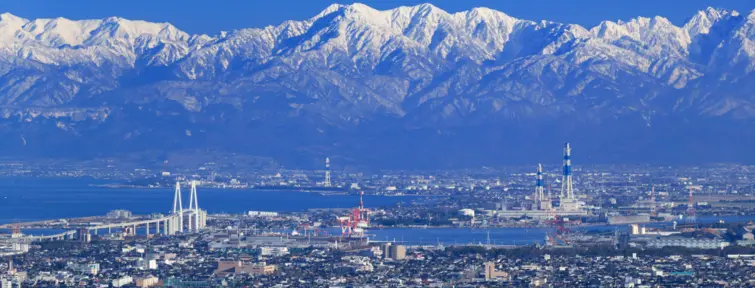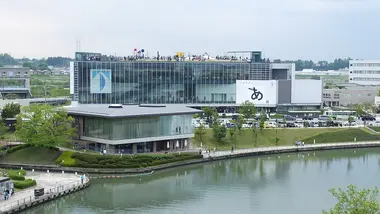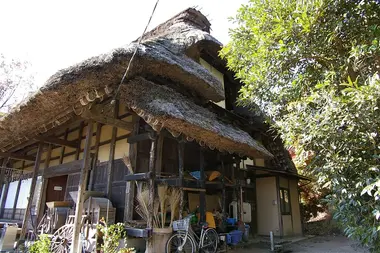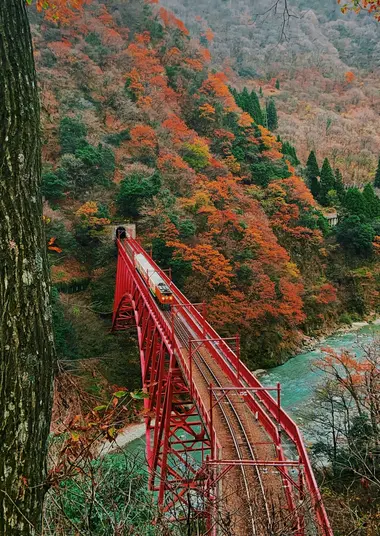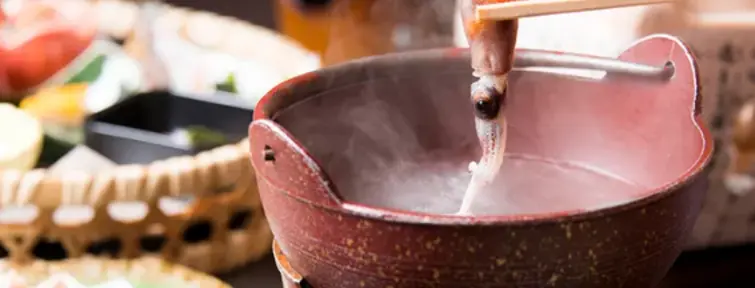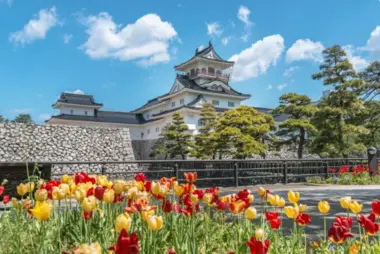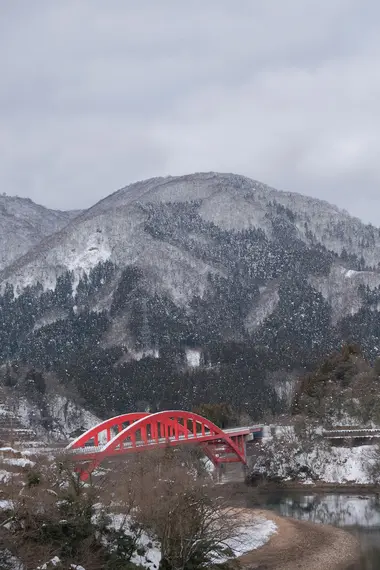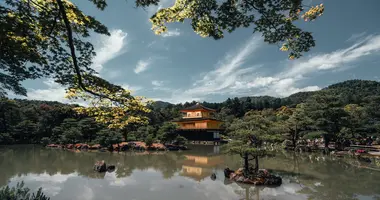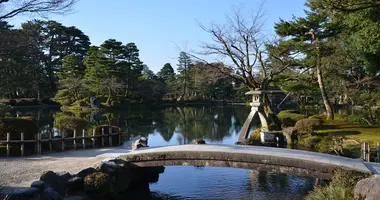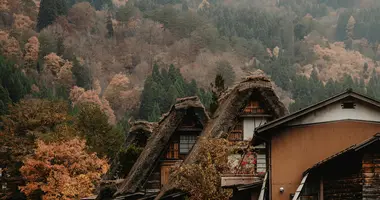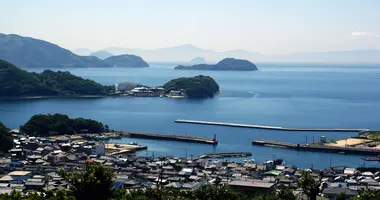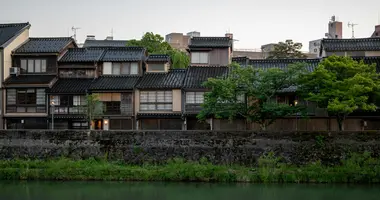Toyama Prefecture Travel Guide
- Published on : 02/09/2025
- by : Ph.L
- Youtube
Nestled along the coast of the Sea of Japan, between flowing rivers and imposing mountains, Toyama Prefecture is a gem of central Japan, brimming with standout experiences and places to discover. It boasts breathtaking vistas throughout the seasons and unusual handicrafts renowned throughout the country. Travel guide to a small prefecture with much to offer.
Pharmaceuticals and glassware: the incredible crafts of Toyama Prefecture
Toyama's pharmaceutical industry began in 1690, during the reign of Lord Maeda Masatoshi of the Toyama estate. The story goes that a local doctor treated a high-ranking official in Edo (present-day Tokyo) with a miraculous remedy. Impressed, the latter encouraged the distribution of these medicines throughout the country. It was at this time that the practice of itinerant pharmacists was born, and with them, Toyama established itself as "the pharmacy of Japan."
Glassmaking was directly linked to this industry. In response to the growing demand for medicine bottles, glassmaking developed in Toyama. The prefecture has carefully preserved this heritage. Even today, the region boasts the largest number of glass artists in the archipelago outside Tokyo.
Toyama, a historic city strewn between rivers and mountains
Bordered by the Sea of Japan, Toyama has a rich history, shaped by its geographical location and maritime trade. A two-day tour of the prefectural capital.
- Toyama Castle
- Sato Memorial Art Museum
- Matsukawa River
- Fugan Canal Kansui Park
- Toyama Prefectural Museum of Art and Design
- Glass Museum
- Science Museum
- Chokeji Temple
- Toyama Bay and Iwase Port
Day 1
Visit Toyama Castle, the city's landmark. In addition to Toyama Johshi Park, the castle is home to the Sato Memorial Art Museum, a museum dedicated to the delicate arts of painting, calligraphy and tea ceremony ceramics.
The Matsukawa River borders the park. Popular in spring for its cherry blossoms, it is also the starting point for scenic cruises, ideal for discovering Toyama from the water.
Stop off at one of the many restaurants in the Sogawa shopping district. Taste the region's seafood specialties before continuing your visit in the direction of Fugan Canal Kansui Park, a water-based recreational park located around 500 m from Toyama Station, featuring a cafe, Tenmonkyo Bridge and two observation towers. Nearby, the Prefectural Museum of Art and Design offers a breathtaking view of the canal. Fashion lovers can admire the staff uniforms designed by the famous designer Issey Miyake. A cruise to the north of the city is also available from Fugan Canal Kansui Park, sailing 2 km upstream to the Nakajima Lock—an early 20th-century lock gate inspired by those on the Panama Canal. End the day at the Museum of Glass, designed by Kengo Kuma.
Day 2
Discover Toyama Folkcraft Village. Set in the pleasant wooded hills of Kurehayama Park, it houses several museums devoted to the region's crafts, including ceramics, glasswork and pharmaceuticals. The Science Museum, a twenty-minute bus ride from Folcraft Village, traces the history of the itinerant merchants who made the prefecture famous.
After lunch, off to Chokeji Temple, famous for its 500 statues of rakan—disciples of Buddha—set out on the hill near the temple.
End your day on the bay with a stroll through the historic port of Iwase. The Baba family residence, houses dating back to the Meiji period (1868-1912), and six Michelin-starred restaurants, including the KOBO craft beer brewery and the Saseki sake bar of the renowned Masuda Sake Brewery, are all worth a visit.
The Alpine Road and the Kurobe Gorge: breathtaking excursions!
As the gateway to the Japanese Alps, Toyama offers easy access to the mountains and hot springs of Tateyama, Shinano-omachi, Kurobe and Unazuki. The mountain roads through Chubu Sangaku National Park are only accessible during fine weather (generally from May to November). The route between Toyama and Shinano-omachi is known as the Tateyama Kurobe Alpine Road and covers a distance of around 90 km (56 miles), which will amaze many a visitor!
- Kurobe Gorge
- Unazuki Onsen
- Tateyama and Bijodaira
- Murodo and surrounding area
- Yuki-no-Otani Snow Wall Walk
Day 1
The Kurobe Gorge is the deepest gorge in Japan and can be reached from the town of Kurobe by the Kurobe Gorge Railway scenic train. Stop off at Katsuri to enjoy open-air hot springs and suspension bridges. At Keyakidaira, explore the trails leading to the Hitokui-iwa and Meiken waterfalls.
Unazuki Onsen is an excellent base for exploring the gorge. This spa is the largest in Toyama Prefecture. Enjoy the splendid views from your ryokan or hotel. The small streets that line the resort are dotted with stores and restaurants, ideal for discovering local produce.
Day 2
From Unazuki Onsen, take the train to Tateyama. Take the funicular to Bijodaira, a magnificent cedar forest. Murodo, accessible by panoramic bus from Tateyama, is the highest point on the Tateyama Kurobe alpine route and offers excellent panoramic views at over 2,400 meters altitude. Choose from the many hiking trails available to explore the surrounding area.
Our suggestion: The Yuki-no-Otani Snow Wall Walk. Around 1 km long, it can be visited from mid-April to June from Murodo station, with snow walls up to 20 meters high! At the end of the day, return to Toyama for the night.
Take to the Alps with Japan Experience
Explore outside of Tokyo, breathe in the pure mountain air, reach for the clouds, and contemplate awe-inspiring landscapes in just 2 days? That's what this Alpine tour is all about.

Tateyama
@unsplash
A gastronomic crossroads
Toyama Prefecture is renowned throughout Japan for its seafood. On the menu? Yellowtail, firefly squid, snow crab, and glass shrimp.
The region's culinary specialties include masu-zushi, a form of pressed sushi made from trout wrapped in fragrant bamboo leaves. Black ramen, made with concentrated soy broth, is also popular on the archipelago, as is Kuromame Okowa, a dish of glutinous rice with black beans.
Activities for all seasons
- Spring/Summer
The warmer weather is the perfect opportunity to discover the prefecture in a different way. In addition to cruises on the Matsukawa River, Toyama boasts a number of refreshing beaches: Yaezuhama, Iwasehama and Hamakurosaki.
Spring also marks the cherry blossom season. In mid-April, the Shio-no-senbon Sakura path along the Jinzu River sees over 1,000 sakura trees in bloom. At Takaoka Castle, over 1,800 cherry trees surround the moat!
From May onwards, enjoy the festivals. In the small village of Yatsuo, lantern-covered floats parade through the streets for the Yatsuo Hikiyama Festival. In summer, the village hosts the Owara Kaze-no-Bon Festival, during which locals, dressed in straw hats and kimonos, dance in the streets to the sound of the shamisen (three-stringed instrument) and kokyu (Japanese violin). In August, the Toyama Summer Fireworks Festival lights up Toyama's skies with beautiful fireworks.
- Autumn/Winter
Autumn is the most popular season for visiting the region. And with good reason: it's at this time of year that the leaves turn gold and purple. The Jinzu River Gorge Prefectural Park offers a spectacular view of the gorge to all hikers who reach it (1 hr walk from the Ioridani bus stop, 1 hr bus ride from Toyama).
Seasonal festivals include the Etchu Owara Kaze-no-Bon in September, in the mountainous areas of Toyama, featuring several thousand paper-covered lampposts. For the occasion, locals dressed in happi coats and yukata dance around the hillside village to the sound of live music featuring traditional instruments.
In winter, indulge in the joys of skiing! Renowned for its spectacular scenery and quality snow, the Kurobe Alpine Garden resort will appeal to seasoned skiers. In Chubu-Sangaku National Park, Tateyama Ski Resort offers an idyllic setting for winter sports. For family holidays, opt for Ikuo Ski Resort and its well-groomed slopes.
Not very sporty? Then it's time to visit Ainokura and Suganuma, two UNESCO World Heritage villages. In winter, they offer an exceptional landscape with their traditional snow-covered houses (gasshō-zukuri). Less crowded than Shirakawa-go, they offer the chance to take in the sights without the crowds.
How to travel in Toyama prefecture?
- Getting to Toyama
Toyama is served by the JR Hokuriku Line and the JR Express Thunderbird to Osaka (approx. 3 hours) and Kyoto (2.5 hours).
From Tokyo, take the Hokuriku Shinkansen (2 hours on the Kagayaki train and 2.5 hours on the Hakutaka train). From Toyama to Tokyo, the Kagayaki train will stop at Nagano, Omiya and Ueno. The slower Hakutaka service stops at Kurobe-Unazuki Onsen, Itoigawa, Jyoetsu-Myoko, Iiyama, Nagano, Takasaki, Omiya and Ueno.
Toyama can also be reached from Nagoya. Take the Hida service via Takayama (3.5 hours) on the JR Takayama main line or the Shirasagi via Maibara service on the JR Hokuriku main line. Alternatively, you can take the Tokaido Shinkansen from Nagoya and change at Maibara for the express train to Kanazawa, then Toyama.
Toyama can be reached by Hokuriku Shinkansen from Kanazawa (approx. 20 minutes). The Tsurugi and Hakutaka trains provide a full-stop service between Toyama and Kanazawa. Shin-Takaoka station (for the city of Takaoka) is just 8 minutes from Toyama station. To reach Takaoka station from Shin-Takaoka station, change to the Johana line (3 minutes). Takaoka Station is also 18 minutes from Toyama Station on an Ainokaze Toyama Railway train.
- Getting around Toyama prefecture
Toyama is served by a system of streetcars and buses that run throughout the city, as well as by the Portram light rail system serving Iwase, the former port area. Bicycles can also be rented at Toyama Station and other locations in the city.
The Centram tramway makes a loop through downtown Toyama. Day tickets provide unlimited travel on local trains, railroads and buses for less than 700 yen per person (350 yen for children).
To visit the Kurobe Gorge, consider the Tateyama Kurobe Option Ticket or the Alpine-Takayama-Matsumoto Area Tourist Pass.
